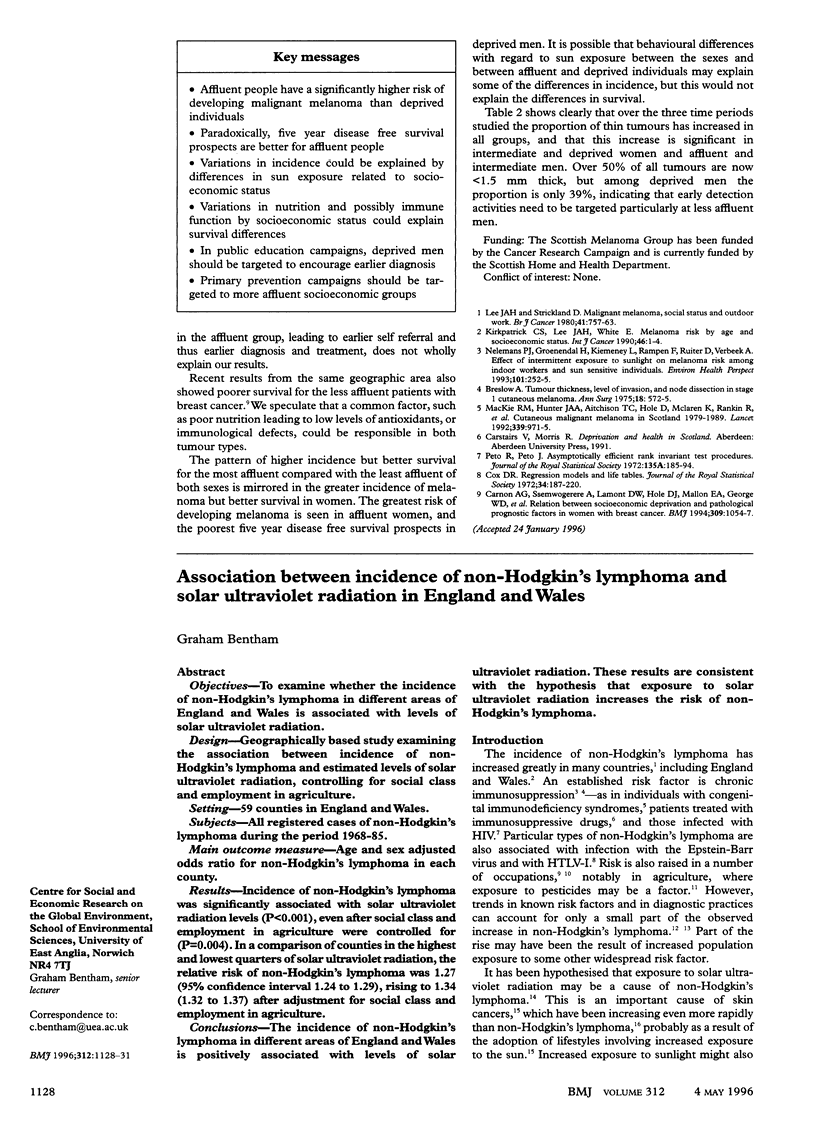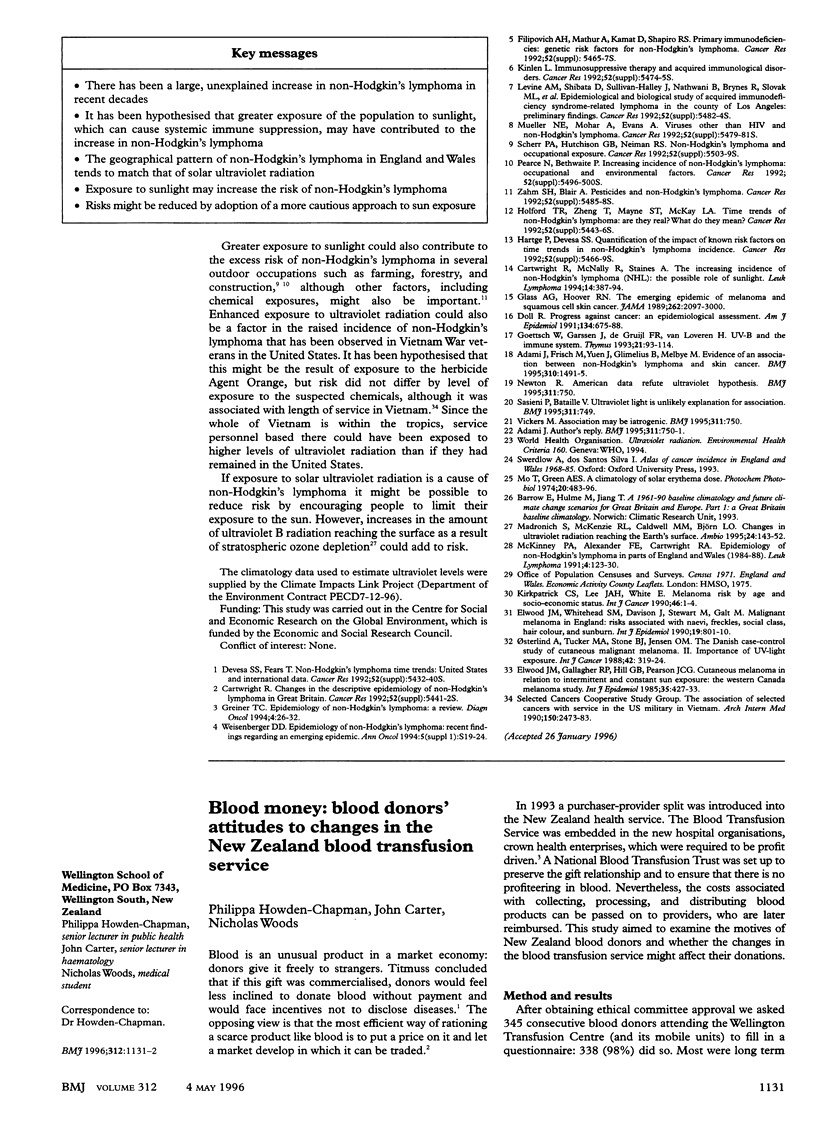Abstract
OBJECTIVES--To examine whether the incidence of non-Hodgkin's lymphoma in different areas of England and Wales is associated with levels of solar ultraviolet radiation. DESIGN--Geographically based study examining the association between incidence of non-Hodgkin's lymphoma and estimated levels of solar ultraviolet radiation, controlling for social class and employment in agriculture. SETTING--59 counties in England and Wales. SUBJECTS--All registered cases of non-Hodgkin's lymphoma during the period 1968-85. MAIN OUTCOME MEASURE--Age and sex adjusted odds ratio for non-Hodgkin's lymphoma in each county. RESULTS--Incidence of non-Hodgkin's lymphoma was significantly associated with solar ultraviolet radiation levels (P < 0.001), even after social class and employment in agriculture were controlled for (P = 0.004). In a comparison of counties in the highest and lowest quarters of solar ultraviolet radiation, the relative risk of non-Hodgkin's lymphoma was 1.27 (95% confidence interval 1.24 to 1.29), rising to 1.34 (1.32 to 1.37) after adjustment for social class and employment in agriculture. CONCLUSIONS--The incidence of non-Hodgkin's lymphoma in different areas of England and Wales is positively associated with levels of solar ultraviolet radiation. These results are consistent with the hypothesis that exposure to solar ultraviolet radiation increases the risk of non-Hodgkin's lymphoma.
Full text
PDF



Selected References
These references are in PubMed. This may not be the complete list of references from this article.
- Adami J., Frisch M., Yuen J., Glimelius B., Melbye M. Evidence of an association between non-Hodgkin's lymphoma and skin cancer. BMJ. 1995 Jun 10;310(6993):1491–1495. doi: 10.1136/bmj.310.6993.1491. [DOI] [PMC free article] [PubMed] [Google Scholar]
- Cartwright R., McNally R., Staines A. The increasing incidence of non-Hodgkin's lymphoma (NHL): the possible role of sunlight. Leuk Lymphoma. 1994 Aug;14(5-6):387–394. doi: 10.3109/10428199409049694. [DOI] [PubMed] [Google Scholar]
- Doll R. Progress against cancer: an epidemiologic assessment. The 1991 John C. Cassel Memorial Lecture. Am J Epidemiol. 1991 Oct 1;134(7):675–688. doi: 10.1093/oxfordjournals.aje.a116143. [DOI] [PubMed] [Google Scholar]
- Elwood J. M., Gallagher R. P., Hill G. B., Pearson J. C. Cutaneous melanoma in relation to intermittent and constant sun exposure--the Western Canada Melanoma Study. Int J Cancer. 1985 Apr 15;35(4):427–433. doi: 10.1002/ijc.2910350403. [DOI] [PubMed] [Google Scholar]
- Elwood J. M., Whitehead S. M., Davison J., Stewart M., Galt M. Malignant melanoma in England: risks associated with naevi, freckles, social class, hair colour, and sunburn. Int J Epidemiol. 1990 Dec;19(4):801–810. doi: 10.1093/ije/19.4.801. [DOI] [PubMed] [Google Scholar]
- Glass A. G., Hoover R. N. The emerging epidemic of melanoma and squamous cell skin cancer. JAMA. 1989 Oct 20;262(15):2097–2100. [PubMed] [Google Scholar]
- Goettsch W., Garssen J., de Gruijl F. R., van Loveren H. UV-B and the immune system. A review with special emphasis on T cell-mediated immunity. Thymus. 1993 Mar;21(2):93–114. [PubMed] [Google Scholar]
- Kirkpatrick C. S., Lee J. A., White E. Melanoma risk by age and socio-economic status. Int J Cancer. 1990 Jul 15;46(1):1–4. doi: 10.1002/ijc.2910460102. [DOI] [PubMed] [Google Scholar]
- Mo T., Green A. E. A climatology of solar erythema dose. Photochem Photobiol. 1974 Dec;20(6):483–496. doi: 10.1111/j.1751-1097.1974.tb06607.x. [DOI] [PubMed] [Google Scholar]
- Newton R. Non-Hodgkin's lymphoma and skin cancer. American data refute ultraviolet hypothesis. BMJ. 1995 Sep 16;311(7007):750–751. doi: 10.1136/bmj.311.7007.750a. [DOI] [PMC free article] [PubMed] [Google Scholar]
- Osterlind A., Tucker M. A., Stone B. J., Jensen O. M. The Danish case-control study of cutaneous malignant melanoma. II. Importance of UV-light exposure. Int J Cancer. 1988 Sep 15;42(3):319–324. doi: 10.1002/ijc.2910420303. [DOI] [PubMed] [Google Scholar]
- Pérez Carrión R., Alberola Candel V., Calabresi F., Michel R. T., Santos R., Delozier T., Goss P., Mauriac L., Feuilhade F., Freue M. Comparison of the selective aromatase inhibitor formestane with tamoxifen as first-line hormonal therapy in postmenopausal women with advanced breast cancer. Ann Oncol. 1994;5 (Suppl 7):S19–S24. [PubMed] [Google Scholar]
- Sasieni P., Bataille V. Non-Hodgkin's lymphoma and skin cancer. Ultraviolet light is unlikely explanation for association. BMJ. 1995 Sep 16;311(7007):749–751. doi: 10.1136/bmj.311.7007.749a. [DOI] [PMC free article] [PubMed] [Google Scholar]
- Vickers M. Non-Hodgkin's lymphoma and skin cancer. Association may be iatrogenic. BMJ. 1995 Sep 16;311(7007):750–751. doi: 10.1136/bmj.311.7007.750. [DOI] [PMC free article] [PubMed] [Google Scholar]


